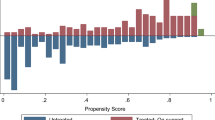Abstract
This article contains a comparison of the profits of cultivating modern and traditional varieties of coconuts as a monocrop and as an intercrop, in ideal and in average growing conditions, with good and with average management. We carry out the analysis from a private (financial) and from a national (economic) perspective. The results show that intercropping generates more income than monocropping. In the conclusion we discuss why development organizations and Third World countries encourage monocropping.
Similar content being viewed by others
References
Asian and Pacific Community (APCC) (1986).Coconut Statistical Yearbook. Jakarta.
Asnawi, S. (1985).Tanaman Kelapa Rakyat di Pulau Jawa. Coconut Research Institute, Indonesia.
Balasubramanian, V., and Egli, A. (1987). The role of agroforestry in the farming system in Rwanda with special reference to the Bugesera-Gisaka-Migongo (BGM) region.Agroforestry Systems 4: 271–289.
Belishaw, D. (1980). Taking indigenous technology seriously: The case of intercropping techniques in East Africa. In Brokenshaw, D., Warren, D., and Werner, O. (eds.),Indigenous Knowledge Systems and Development, University Press of America, Washington, pp. 195–201.
Bennett, C. P. A. (1986). Mapping the Principal Tree Crop Farming Systems in Indonesia. Center for Policy and Implementation Studies, Ministry of Finance, Government of Indonesia.
Bennett, C. P. A., and Godoy, R. (1987). An Economic Evaluation of Planting Hybrid and Tall Variety Coconuts in Indonesia. Center for Policy and Implementation Studies, Ministry of Finance, Government of Indonesia.
Bennett, C. P. A., Hosang, M. L. A., and Assa, B. H. (1986).Observations of pests and diseases of the coconut, Cocos nucifera L. in the Northern Islands of Maluku. Coconut Research Institute, Indonesia.
Bernard, R. H., et al. (1984). The problem of informant accuracy: The validity of retrospective data.Annual Review of Anthropology 13: 495–517.
Bourke, M. R. (1985). Food, coffee and casuarina: An agroforestry system from the Papua New Guinea Highlands.Agroforestry Systems 2: 273–79.
Burgess, R. J. (1981). The Intercropping of Smallholder Coconuts in Western Samoa; An Analysis Using Multi-Stage Linear Programming. Development Studies Centre, MADE Research Series No. 4. The Australian National University, Canberra.
Child, R. (1974).Coconuts. Longman, London.
De Lamothe, M. de N., and Rognon, F. (1975). L'hybride Port-Bouet 121. Nouveaux resultats.Coconuts Today, June 12.
Dinas Pertanian (1984).Pengembangan Tanaman Kedele Menuju Agribisnis Tanaman Pangan di Sulawesi Ultara. Extension Service for Food Crops, Manado, Indonesia.
Fernandes, E. C. M., and Nair, P. K. R. (1986). An evaluation of the structure and function of tropical homegardens.Agricultural Systems 21: 279–310.
Food and Agriculture Organization (FAO) (1986).Tree Growing by Rural People. FAO Forestry Paper No. 64. Rome.
Govinden, N. (1984). Intercropping in the tropics: Advantages and relevance to the small farmer.Canadian Journal of Development Studies 5: 213–232.
Kaat, H., Darwis, S. N., and Davis, T. A. (1985). Intercropping with tall variety coconuts in North Sulawesi.Jurnal Penelitian Kelapa 1(1): 11–24.
Keswani, C. L., and Ndunguru, B. J. (eds.) (1982).Intercropping. Proceedings of the Second Symposium on Intercropping in Semi-Arid Areas held in Tanzania, August 4–7, 1980, IDRC, Ottawa.
Liyanage, M. D. S., Tejawani, K. G., and Nair, P. K. R. (1984). Intercropping under coconuts in Sri Lanka.Agroforestry Systems 2: 215–228.
McDowell, R. E., and Hildebrand, P. E. (1980). Integrated Crop and Animal Production. Making the Most of Resources Available to Small Farms in Developing Countries. A Bellagio Conference, October 18–23, 1978, The Rockefeller Foundation.
Nair, P. K. R. (1983). Agroforestry with coconuts and other tropical plantation crops. InPlant Research and Agroforestry. International Council for Research in Agroforestry, Nairobi, pp. 79–101.
Ohler, J. G. (1984).Coconut, Tree of Life, FAO, Plant Production and Protection Paper No. 57.
Ouvrier, M. (1984). Etude de la croissance et du développement du cocotier hybride PB-121 (NJM x GOA) au jeune age.Oleagineux 39(2): 73–82.
Pau, T. Y., and Chan, E. (1985). Optimum density for MAWA hybrid coconuts (PB 121).Oleagineux 40(4): 189–193.
Plucknett, D. L. (1979).Managing Pasture and Cattle Under Coconuts. Westview Press, Boulder.
Purseglove, J. W. (1968).Tropical Crops-Dicotyledons. Longman, London.
Richards, P. (1985).Indigenous Agricultural Revolution-Ecology and Food Production in West Africa. Hutchinson Press, London.
Ruthenberg, H. (1971).Farming Systems in the Tropics. Clarendon Press, Oxford.
Sampson, H. C. (1923).The Coconut Palm: The Science and Practice of Cultivation. Balle, Sons and Danielsson, London.
Sampson, H. C., and Crowther, E. M. (1943). Crop Production and Soil Fertility Problems. The West Africa Commission 1938–39: Technical Reports (Part 1). Leverhulme Trust, London.
Santos, G. A., Carpio, C. B., Ilagan, M. C., Cano, S. B., and De La Cruz, B. V. (1982). Flowering and early yield performance of four IRHO coconut hybrids in the Philippines.Oleagineux 37(12): 571–580.
Sondak, L. (1984).Growth and Equity Aspects of Credit for Small Coconut Farm Development in Sulawesi Utara. Ph.D. dissertation, University of New England, New South Wales, Australia.
Sondak, L. (1986). Problems and Prospects of the Small-Farm Coconut Development Project (SCDP) in North Sulawesi. Center for Policy and Implementation Studies, Ministry of Finance, Government of Indonesia.
Vandermeer, J. H. (1988).The Ecology of Intercropping. Cambridge University Press, Cambridge.
Vandermeer, J. H. (1990). Intercropping. In Carroll, C. R., Vandermeer, J. H., and Rosset, P. M. (eds.),Agroecology, McGraw-Hill Publishers, New York, pp. 481–515.
Weaver, P. (1979). Agri-silviculture in tropical America.Unasylva 31(126): 2–12.
Wood, P. J. (1984). Mixed Systems of Plant Production in Africa: Past, Present, and Future. ICRAF Working Paper No. 20, Nairobi.
World Bank (1985).Indonesia: The Major Tree Crops, A Sector Review. Jakarta.
Yudelman, M. (1985).The World Bank and Agricultural Development: An Insider's View. WRI Paper No. 1, Washington, D.C.
Author information
Authors and Affiliations
Rights and permissions
About this article
Cite this article
Godoy, R., Bennett, C.P.A. The economics of monocropping and intercropping by smallholders: The case of coconuts in Indonesia. Hum Ecol 19, 83–98 (1991). https://doi.org/10.1007/BF00888978
Issue Date:
DOI: https://doi.org/10.1007/BF00888978




